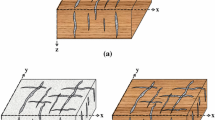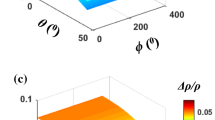Abstract
Young’s modulus, Poisson’s ratio, and fracture excess compliances, which are related to rock brittleness and natural fractures, can be used to evaluate the hydraulic fracturing and infer the optimized sweet spots in unconventional reservoirs. We aim to characterize the elastic properties of rock brittleness and compliance from the observable wide-azimuth seismic data via the inversion of Young’s modulus, Poisson’s ratio, and excess compliances. Using the linear slip model, we first derive the perturbations in stiffness components in terms of Young’s modulus, Poisson’s ratio, and excess compliances for the case of weak anisotropy and small contrasts in elastic properties across the interface. Based on the relationship between scattering function and reflection coefficient in weakly anisotropic media, we then derive a linearized PP-wave reflection coefficient and an azimuthal elastic impedance (EI) equation as a function of Young’s modulus, Poisson’s ratio, density, and excess compliances. Finally, we develop an EI variation with incident angle and azimuth inversion method to estimate the Young’s modulus, Poisson’s ratio, and excess compliances in a Bayesian framework. The approach is implemented in a two-step inversion: azimuthal EI inversion and estimation of model parameters. A synthetic test demonstrates that the model parameter can be reasonably estimated even containing moderate noise. A field data set test reveals that the inversion results agree well with the well log interpretation.
















Similar content being viewed by others
References
Alemie W, Sacchi MD (2011) High-resolution three-term AVO inversion by means of a Trivariate Cauchy probability distribution. Geophysics 76:R43–R55
Bachrach R, Sengupta M, Salama A, Miller P (2009) Reconstruction of the layer anisotropic elastic parameter and high resolution fracture characterization from P-wave data: a case study using seismic inversion and Bayesian rock physics parameter estimation. Geophys Prospect 57:253–262
Bakulin A, Grechka V, Tsvankin I (2000a) Estimation of fracture parameters from reflection seismic data-part I: HTI model due to a single fracture set. Geophysics 65:1788–1802
Bakulin A, Grechka V, Tsvankin I (2000b) Estimation of fracture parameters from reflection seismic data-Part II: fractured models with orthorhombic symmetry. Geophysics 65:1803–1817
Bissantz N, Dumbgen L, Munk A, Stratmann B (2009) Convergence analysis of generalized iteratively reweighted least squares algorithms on convex function spaces. J Optimiz 19:1828–1845
Chen H, Brown RL, Castagna JP (2005) AVO for one- and two fracture set models. Geophysics 70:C1–C5
Connolly P (1999) Elastic impedance. Lead Edge 18:438–452
de Nicolao A, Drufuca G, Rocca F (1993) Eigenvalues and eigenvectors of linearized elastic inversion. Geophysics 58:670–679
Debski W, Tarantola A (1995) Information on elastic parameters obtained from the amplitudes of reflected waves. Geophysics 60:1426–1436
Downton JE (2005) Seismic parameter estimation from AVO inversion. Ph.D. thesis, University of Calgary
Downton JE, Roure B (2015) Interpreting azimuthal Fourier coefficients for anisotropic and fracture parameters. Interpretation 3:ST9–ST27
Duffaut K, Alsos T, Landro M, Rognø H, Al-Najjar NF (2000) Shear-wave elastic impedance. Lead Edge 19:1222–1229
Far ME, Hardage B, Wagner D (2014) Fracture parameter inversion for Marcellus Shale. Geophysics 79:C55–C63
Goodway B, Varsek J, Abaco C (2007) Anisotropic 3D amplitude variation with azimuth (AVAZ) methods to detect fracture prone zones in tight gas resource plays. In: CSPG/CSEG convention, pp 590–596
Gray D, Head K (2000) Fracture detection in Manderson field: a 3-D AVAZ case history. Lead Edge 11:1214–1221
Harris NB, Miskimins JL, Mnich CA (2011) Mechanical anisotropy in the Woodford Shale, Permian Basin: origin, magnitude, and scale. Lead Edge 30:284–291
Hudson JA (1980) Overall properties of a cracked solid. Math Proc Camb Philos Soc 88:371–384
Hudson JA (1981) Wave speeds and attenuation of elastic waves in material containing cracks. Geophys J Int 64:133–150
Kabir N, Crider R, Ramkhelawan R, Baynes C (2006). Can hydrocarbon saturation be estimated using density contrast parameter. In: CSEG recorder, pp C31–C37
Koren Z, Ravve I, Levy R (2010) Moveout approximation for horizontal transversely isotropic and vertical transversely isotropic layered medium, part II: effective model. Geophys Prospect 58:599–617
Liu E, Martinez A (2013) Seismic fracture characterization. Concepts and practical application. Academic Press, Cambridge
Mallick S (2001) AVO and elastic impedance. Lead Edge 20:1094–1104
Mallick S (2007) Amplitude-variation-with-offset, elastic-impedence, and wave-equation synthetics—a modeling study. Geophysics 72:C1–C7
Mallick S, Craft KL, Meister LJ, Chambers RE (1998) Determination of the principal directions of azimuthal anisotropy from P-wave seismic data. Geophysics 63:692–706
Martins JL (2006) Elastic impedance in weakly anisotropic media. Geophysics 71:D73–D83
Morozov IB (2010) Exact elastic P/SV impedance. Geophysics 75:C7–C13
Narr W, Schechter WS, Thompson L (2006) Naturally fractured reservoir characterization. Society of Petroleum Engineers, Richardson
Pan X, Zhang G, Yin X (2017a) Azimuthally anisotropic elastic impedance inversion for fluid indicator driven by rock physics. Geophysics 82:C211–C227
Pan X, Zhang G, Yin X (2017b) McMC-based AVAZ direct inversion for fracture weaknesses. J Appl Geophys 138:50–61
Pan X, Zhang G, Yin X (2017c) Estimation of effective geostress parameters driven by anisotropic stress and rock physics models with orthorhombic symmetry. J Geophys Eng 14:1124–1137
Pan X, Zhang G, Yin X (2018a) Azimuthal seismic amplitude variation with offset and azimuth inversion in weakly anisotropic media with orthorhombic symmetry. Surv Geophys 39:99–123
Pan X, Zhang G, Yin X (2018b) Elastic impedance parameterization and inversion for fluid modulus and dry fracture quasi-weaknesses in a gas-filled reservoir. J Nat Gas Sci Eng 49:194–212
Ravve I, Koren Z (2010) Moveout approximation for horizontal transversely isotropic and vertical transversely isotropic layered medium, part I: 1D ray propagation. Geophys Prospect 58:577–597
Rüger A (1997) P-wave reflection coefficients for transversely isotropic models with vertical and horizontal axis of symmetry. Geophysics 62:713–722
Rüger A (1998) Variation of P-wave reflectivity with offset and azimuth in anisotropic media. Geophysics 63:935–947
Russell B, Hampson D (1991) Comparison of poststack seismic inversion methods. In: SEG annual international meeting, expanded abstracts, pp 876–878
Sacchi MD, Ulrych TJ (1995) High-resolution velocity gathers and offset space reconstruction. Geophysics 60:1169–1177
Scales JA, Smith ML (2000) Introductory geophysical inverse theory. Samizdat Press, Tupelo
Schoenberg M (1980) Elastic wave behavior across linear slip interfaces. J Acoust Soc Am 68:1516–1521
Schoenberg M (1983) Reflection of elastic waves from periodically stratified media with interfacial slip. Geophys Prospect 31(2):265–292
Schoenberg M, Douma J (1988) Elastic wave propagation in media with parallel vertical fractures and aligned cracks. Geophys Prospect 36:571–590
Schoenberg M, Helbig K (1997) Orthorhombic media: modeling elastic wave behavior in a vertically fractured earth. Geophysics 62:1954–1957
Schoenberg M, Sayers CM (1995) Seismic anisotropy of fractured rock. Geophysics 60:204–211
Sena A, Castillo G, Chesser K, Voisey S, Estrada J, Carcuz J, Carmona E, Hodgkins P (2011) Seismic reservoir characterization in resource shale plays: “sweet spot” discrimination and optimization of horizontal well placement. In: SEG annual international meeting, expanded abstracts, pp 1744–1748
Shaw RK, Sen MK (2004) Born integral, stationary phase and linearized reflection coefficients in weak anisotropic media. Geophys J Int 158:225–238
Shaw RK, Sen MK (2006) Use of AVOA data to estimate fluid indicator in a vertically fractured medium. Geophysics 71:C15–C24
Thomsen L (1986) Weak elastic anisotropy. Geophysics 51:1954–1966
Tsvankin L, Grechka V (2011) Seismology of azimuthally anisotropic media and seismic fracture characterization. SEG Publication, New York
Whitcombe DN (2002) Elastic impedance normalization. Geophysics 67:60–62
Yin X, Zhang S (2014) Bayesian inversion for effective pore-fluid bulk modulus based on fluid-matrix decoupled amplitude variation with offset approximation. Geophysics 79:R221–R232
Zhang F, Li X (2016) Exact elastic impedance matrices for transversely isotropic medium. Geophysics 81:C1–C15
Zong Z, Yin X, Wu G (2013a) Elastic impedance parameterization and inversion with Young’s modulus and Poisson’s ratio. Geophysics 78:N35–N42
Zong Z, Yin X, Wu G (2013b) Direct inversion for a fluid factor and its application in heterogeneous reservoirs. Geophys Prospect 61:998–1005
Acknowledgements
We would like to express our gratitude to the sponsorship of National Natural Science Foundation of China (41674130, U1562215), National Basic Research Program of China (2014CB239201), and National Grand Project for Science and Technology (2016ZX05027004-001, 2016ZX05002005-09HZ), and the Fundamental Research Funds for the Central Universities for their funding in this research. We also thank Alexey Stovas and another anonymous reviewer for their constructive suggestions.
Author information
Authors and Affiliations
Corresponding author
Appendices
Appendix 1: Linearized PP-Wave Reflection Coefficient and Azimuthal Elastic Impedance in an Orthorhombic Anisotropic Medium
A horizontally layered rock permeated by a single set of aligned, vertical fractures is equivalent to an orthorhombic anisotropic medium (Schoenberg and Helbig 1997; Bakulin et al. 2000b). Following Pan et al. (2018a), we derive the stiffness components of an orthorhombic anisotropic medium based on weak-anisotropy assumption in terms of Young’s modulus, Poisson’s ratio, and excess compliances
where \(Z_{\text{N}}\), \(Z_{\text{V}}\), and \(Z_{\text{H}}\) denote the normal, vertical, and horizontal tangential excess compliances, respectively, and \(\varepsilon_{b}\), \(\delta_{b}\), and \(\gamma_{b}\) denote the Thomsen’s (1986) weak-anisotropy (WA) parameters, which are used to characterize the vertical horizontally isotropic (VTI) medium.
Using the derived stiffnesses in Eq. (16), we ignore the items that proportional to \(\Delta E\left( {Z_{\text{N}} + \Delta Z_{\text{N}} } \right)\), \(\Delta \sigma \left( {Z_{\text{N}} + \Delta Z_{\text{N}} } \right)\), \(\Delta E\left( {Z_{\text{V}} + \Delta Z_{\text{V}} } \right)\), \(\Delta \sigma \left( {Z_{\text{V}} + \Delta Z_{\text{V}} } \right)\), \(\Delta E\left( {Z_{\text{H}} + \Delta Z_{\text{H}} } \right)\), \(\Delta \sigma \left( {Z_{\text{H}} + \Delta Z_{\text{H}} } \right)\), \(\Delta E\left( {\varepsilon_{b} + \Delta \varepsilon_{b} } \right)\), \(\Delta \sigma \left( {\varepsilon_{b} + \Delta \varepsilon_{b} } \right)\), \(\Delta E\left( {\delta_{b} + \Delta \delta_{b} } \right)\), \(\Delta \sigma \left( {\delta_{b} + \Delta \delta_{b} } \right)\), \(\Delta E\left( {\gamma_{b} + \Delta \gamma_{b} } \right)\), \(\Delta \sigma \left( {\gamma_{b} + \Delta \gamma_{b} } \right)\), \(\left( {\Delta E} \right)^{2}\) or \(\left( {\Delta \sigma } \right)^{2}\), we further derive the perturbations in stiffnesses in terms of Young’s modulus, Poisson’s ratio, and excess compliances for the case of weak anisotropy, weak excess compliances, and small contrasts in elastic properties across the interface
where \(\Delta E\), \(\Delta \sigma\), \(\Delta \varepsilon_{b}\), \(\Delta \delta_{b}\), \(\Delta \gamma_{b}\), \(\Delta Z_{\text{N}}\), \(\Delta Z_{\text{V}}\), and \(\Delta Z_{\text{H}}\) denote the contrasts in Young’s modulus, Poisson’s ratio, Thomsen’s WA parameters, and excess compliances across the interface.
Similarly, we then derive the linearized PP-wave reflection coefficient of an orthorhombic anisotropic medium
where \(\bar{E}\), \(\bar{\sigma }\), and \(\bar{\rho }\) represent the averages over the interface, and \(g = {{\left( {1 - 2\bar{\sigma }} \right)} \mathord{\left/ {\vphantom {{\left( {1 - 2\bar{\sigma }} \right)} {\left( {2 - 2\bar{\sigma }} \right)}}} \right. \kern-0pt} {\left( {2 - 2\bar{\sigma }} \right)}}\).
In a similar way, we also derive the azimuthal EI equation in an orthorhombic anisotropic medium
Appendix 2: Decorrelation of Model Parameters
To decorrelate the model parameters, we first calculate the covariance matrix \({\varvec{C}}_{{\varvec{m}}}\) of model parameters
where the diagonal elements denote the variances \(\sigma_{{L_{E} }}^{2}\), \(\sigma_{{L_{\sigma } }}^{2}\), \(\sigma_{{L_{\rho } }}^{2}\), \(\sigma_{{Z_{N} }}^{2}\), and \(\sigma_{{Z_{T} }}^{2}\) of model parameters, and the off-diagonal elements or covariances characterize the correlation of model parameters. Using the singular value decomposition (SVD) method, the parameter covariance matrix \({\varvec{C}}_{{\varvec{m}}}\) is decomposed as (Downton 2005)
where \(\varvec{u}\) represents the eigenvector, and \(\varvec{\sum }\) represents the diagonal matrix of eigenvalues, in which all the values are real and positive (and can be presented as real numbers squared \(\sigma_{i}^{2} ,\text{ }i = 1,2, \ldots ,5\)).
We define the inverse of single-interface eigenvector \(\varvec{u}\) as
For the case of \(J\) interfaces, the single-interface eigenvector \(\varvec{u}\) can be extended as
Here \(\varvec{U}^{ - 1}\) is the inverse of decorrelation matrix \(\varvec{U}\) of multiple interfaces. Using the transformation of the coefficient matrix \({\varvec{G}}\) and model parameter vector \({\varvec{m}}\)
and Eq. (12) yields
The covariance matrix \({\varvec{C}}_{{{\varvec{m^{\prime}}}}}\) after the transformation then becomes
where all the off-diagonal elements become to be zero, which indicates that the model parameters after decorrelation are mutually independent.
Appendix 3: Calculation of Excess Compliances Using Fracture Density
According to the relationship between the excess compliances and fracture density (Bakulin et al. 2000a), we derive the gas-filled, or dry, excess compliances expressed by Young’s modulus \(E\), Poisson’s ratio \(\sigma\), and fracture density \(e\)
and
Rights and permissions
About this article
Cite this article
Pan, X., Zhang, G. & Yin, X. Elastic Impedance Variation with Angle and Azimuth Inversion for Brittleness and Fracture Parameters in Anisotropic Elastic Media. Surv Geophys 39, 965–992 (2018). https://doi.org/10.1007/s10712-018-9491-1
Received:
Accepted:
Published:
Issue Date:
DOI: https://doi.org/10.1007/s10712-018-9491-1




